Pharmacokinetics and Pharmacodynamics of Butorphanol and Dexmedetomidine after Intranasal Administration in Broiler Chickens (Gallus gallus domesticus)
Abstract
:1. Introduction
2. Materials and Methods
2.1. Pharmacokinetic Study
2.1.1. Experimental Animals
2.1.2. Drug Administration and Blood Sampling
2.1.3. Drug Determination in Plasma
2.1.4. Sample Preparation
2.1.5. Liquid Chromatography and Mass Spectrometry (LCMS) Conditions
2.1.6. LCMS Validation
2.1.7. Pharmacokinetic Analysis
2.2. Evaluation of Sedation and Analgesia
2.2.1. Experimental Animals and Drug Administration
2.2.2. Sedation Assessment
2.2.3. Mechanical Nociceptive Threshold (Analgesia) Testing
2.2.4. Statistical Analysis
3. Results
3.1. LCMS Validation and Pharmacokinetic Analysis
3.2. Sedation Score
3.3. Mechanical Nociceptive Thresholds
4. Discussion
5. Conclusions
Author Contributions
Funding
Institutional Review Board Statement
Informed Consent Statement
Data Availability Statement
Acknowledgments
Conflicts of Interest
References
- Hunter, D.B. Clinical Avian Medicine and Surgery. Can. Vet. J. 1987, 28, 289. Available online: www.ncbi.nlm.nih.gov/pmc/articles/PMC1680460/ (accessed on 8 February 2022).
- Coles, B. Avian Medicine and Surgery, 2nd ed.; Blackwell Science: Oxford, UK, 1997; Volume 81, p. 210. [Google Scholar]
- Hawkins, M.G. The use of analgesics in birds, reptiles, and small exotic mammals. J. Exot. Pet Med. 2006, 15, 177–192. [Google Scholar] [CrossRef]
- SİZER, S.S.; Kabak, M.; Burcu, O. An investigation on the renal portal system in long-legged buzzard (Buteo rufinus). Ank. Üniversitesi Vet. Fakültesi Derg. 2020, 68, 21–25. [Google Scholar] [CrossRef]
- Askar, R.; Frederiksson, E.; Manell, E.; Hedeland, M.; Bondesson, U.; Bate, S.; Olsen, L.; Hedenqvist, P. Bioavailability of subcutaneous and intramuscular administrated buprenorphine in New Zealand White rabbits. BMC Vet. Res. 2020, 16, 3774. [Google Scholar] [CrossRef] [PubMed]
- Doss, G.A.; Fink, D.M.; Mans, C. Assessment of sedation after intranasal administration of midazolam and midazolam-butorphanol in cockatiels (Nymphicus hollandicus). Am. J. Vet. Res. 2018, 79, 1246–1252. [Google Scholar] [CrossRef]
- Hornak, S.; Liptak, T.; Ledecky, V.; Hromada, R.; Bilek, J.; Mazensky, D.; Petrovic, V. A preliminary trial of the sedation induced by intranasal administration of midazolam alone or in combination with dexmedetomidine and reversal by atipamezole for a short-term immobilization in pigeons. Vet. Anaesth. Analg. 2015, 42, 192–196. [Google Scholar] [CrossRef]
- Sadegh, A.B. Comparison of intranasal administration of xylazine, diazepam, and midazolam in budgerigars (Melopsittacus undulatus): Clinical evaluation. J. Zoo Wildl. Med. 2013, 44, 241–244. Available online: www.jstor.org/stable/24549998 (accessed on 8 February 2022). [CrossRef]
- Speer, B. Current Therapy in Avian Medicine and Surgery; Elsevier Health Sciences: St Louis, MO, USA, 2015; pp. 605–606. [Google Scholar]
- Mans, C. Sedation of pet birds. J. Exot. Pet Med. 2014, 23, 152–157. [Google Scholar] [CrossRef]
- Paul-Murphy, J. Analgesia in Birds—Part 2: Opioids and Locals. Available online: https://www.vetfolio.com/learn/article/analgesia-in-birds-part-2-opioids-and-locals (accessed on 8 February 2022).
- Singh, P.M.; Johnson, C.B.; Gartrell, B.; Mitchinson, S.; Jacob, A.; Chambers, P. Analgesic effects of morphine and butorphanol in broiler chickens. Vet. Anaesth. Analg. 2017, 44, 538–545. [Google Scholar] [CrossRef]
- Lichtenberger, M.; Ko, J. Anesthesia and analgesia for small mammals and birds. Vet. Clin. N. Am. Exot. Anim. Pract. 2007, 10, 293–315. [Google Scholar] [CrossRef]
- Pollock, C.G.; Schumacher, J.; Orosz, S.E.; Ramsay, E. Sedative effects of medetomidine in pigeons (Columba livia). J. Avian Med. Surg. 2001, 15, 95–100. [Google Scholar] [CrossRef]
- Gentle, M.; Hocking, P.; Bernard, R.; Dunn, L. Evaluation of intraarticular opioid analgesia for the relief of articular pain in the domestic fowl. Pharmacol. Biochem. Behav. 1999, 63, 339–343. [Google Scholar] [CrossRef]
- Zhang, Y.; Huo, M.; Zhou, J.; Xie, S. PKSolver: An add-in program for pharmacokinetic and pharmacodynamic data analysis in Microsoft Excel. Comput. Methods Programs Biomed. 2010, 99, 306–314. [Google Scholar] [CrossRef] [PubMed]
- Hothersall, B.; Caplen, G.; Nicol, C.; Taylor, P.; Waterman-Pearson, A.; Weeks, C.; Murrell, J. Development of mechanical and thermal nociceptive threshold testing devices in unrestrained birds (broiler chickens). J. Neurosci. Methods 2011, 201, 220–227. [Google Scholar] [CrossRef] [PubMed]
- Santangelo, B.; Ferrari, D.; Di Martino, I.; Belli, A.; Cordella, C.; Ricco, A.; Troisi, S.; Vesce, G. Dexmedetomidine chemical restraint of two raptor species undergoing inhalation anaesthesia. Vet. Res. Commun. 2009, 33, 209–211. [Google Scholar] [CrossRef] [PubMed]
- Guzman, D.S.-M.; Flammer, K.; Paul-Murphy, J.R.; Barker, S.A.; Tully, T.N. Pharmacokinetics of butorphanol after intravenous, intramuscular, and oral administration in Hispaniolan Amazon parrots (Amazona ventralis). J. Avian Med. Surg. 2011, 25, 185–192. [Google Scholar] [CrossRef]
- Mans, C.; Guzman, D.S.-M.; Lahner, L.L.; Paul-Murphy, J.; Sladky, K.K. Sedation and physiologic response to manual restraint after intranasal administration of midazolam in Hispaniolan Amazon parrots (Amazona ventralis). J. Avian Med. Surg. 2012, 26, 130–139. [Google Scholar] [CrossRef] [PubMed]
- Ahsan, M.Z.; Khan, F.U.; Zhao, M.-J.; Wang, Y.-X. Synergistic interaction between butorphanol and dexmedetomidine in antinociception. Eur. J. Pharm. Sci. 2020, 149, 105322. [Google Scholar] [CrossRef]
- Singh, P.; Johnson, C.; Gartrell, B.; Mitchinson, S.; Chambers, P. Pharmacokinetics of butorphanol in broiler chickens. Vet. Rec. 2011, 168, 588. [Google Scholar] [CrossRef]
- Dyce, K.M.; Sack, W.O.; Wensing, C.J.G. Textbook of Veterinary Anatomy, 4th ed.; Saunders, Elsevier Publishers: St Louis, MO, USA, 2010; p. 794. [Google Scholar]
- Micieli, F.; Santangelo, B.; Reynaud, F.; Mirra, A.; Napoleone, G.; Della Valle, G.; Portier, K.G.; Vesce, G. Sedative and cardiovascular effects of intranasal or intramuscular dexmedetomidine in healthy dogs. Vet. Anaesth. Analg. 2017, 44, 703–709. [Google Scholar] [CrossRef]
- Santangelo, B.; Micieli, F.; Mozzillo, T.; Reynaud, F.; Marino, F.; Auletta, L.; Vesce, G. Transnasal administration of a combination of dexmedetomidine, midazolam and butorphanol produces deep sedation in New Zealand White rabbits. Vet. Anaesth. Analg. 2016, 43, 209–214. [Google Scholar] [CrossRef] [PubMed]
- Hunter, R.P.; Mahmood, I.; Martinez, M.N. Prediction of xenobiotic clearance in avian species using mammalian or avian data: How accurate is the prediction? J. Vet. Pharmacol. Ther. 2008, 31, 281–284. [Google Scholar] [CrossRef] [PubMed]
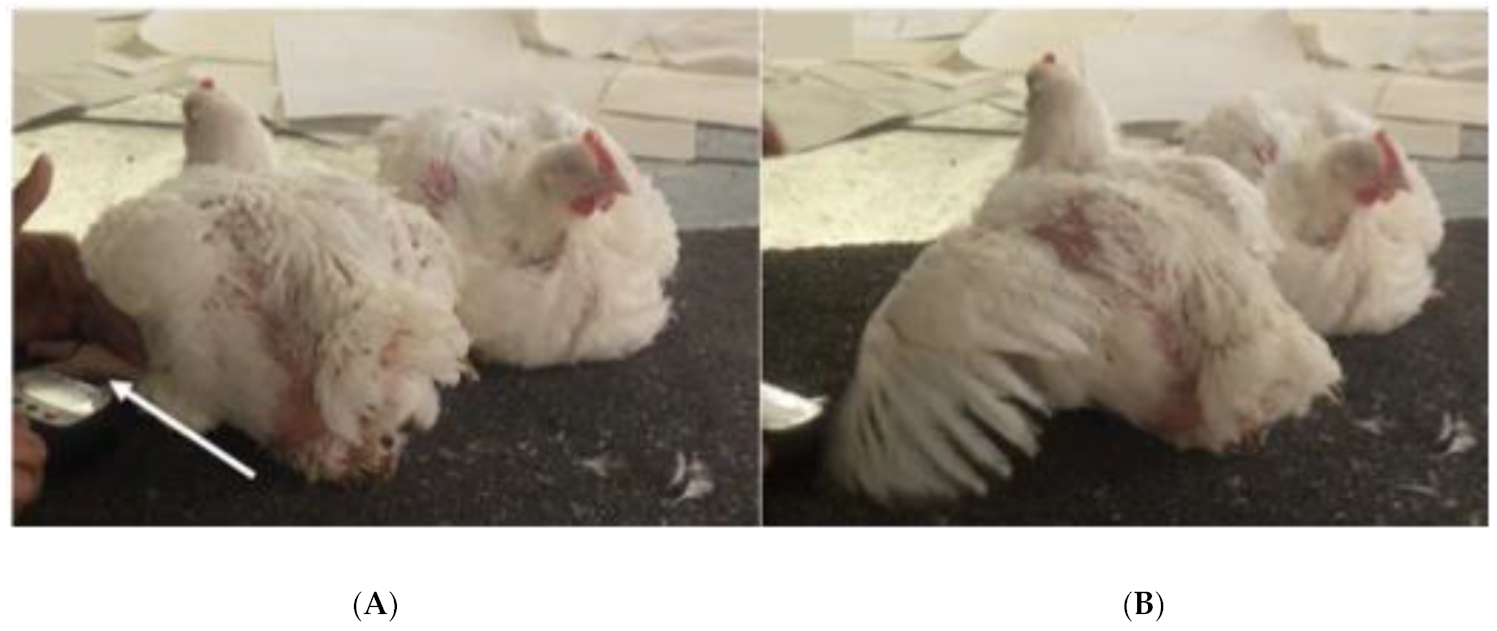
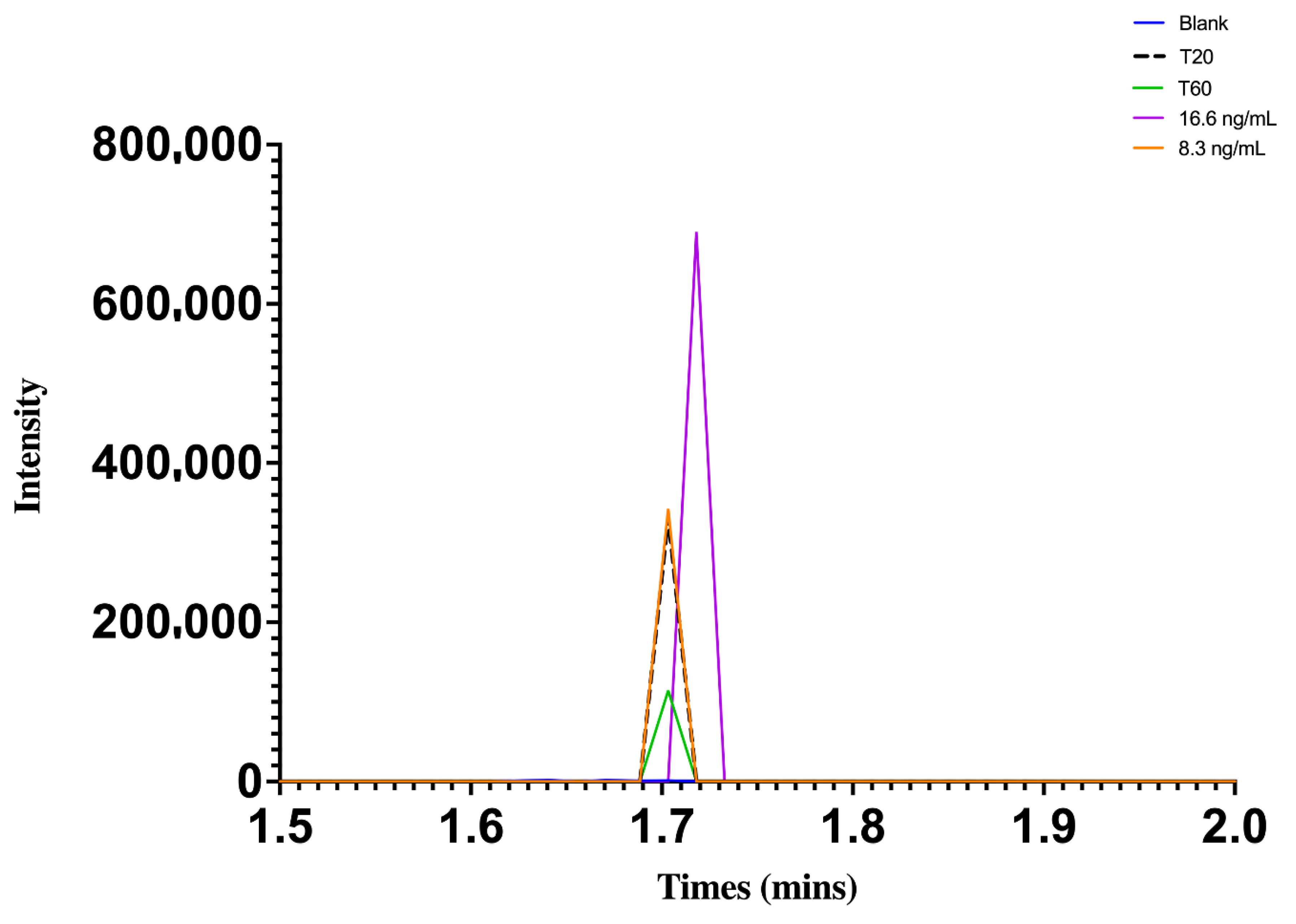
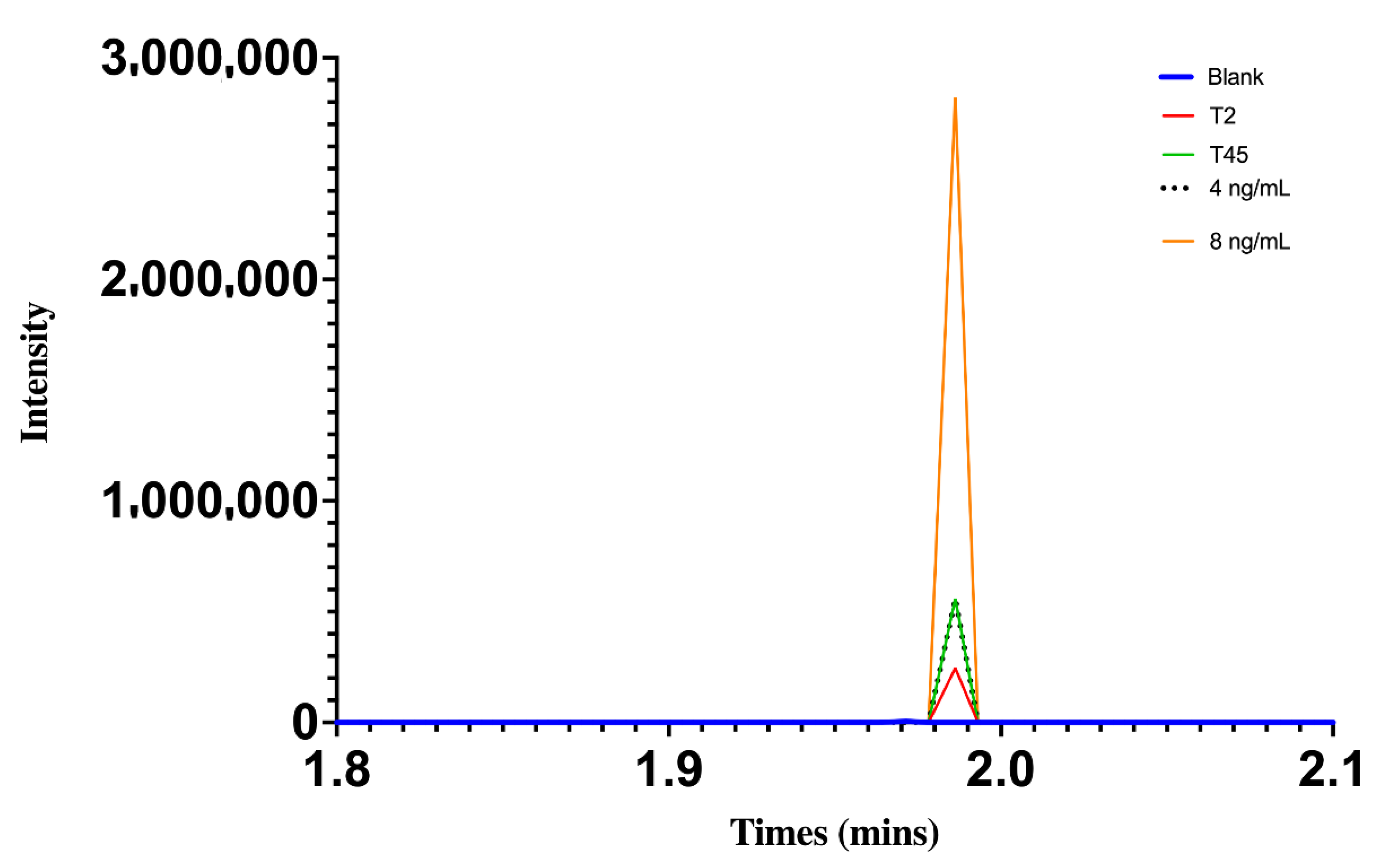
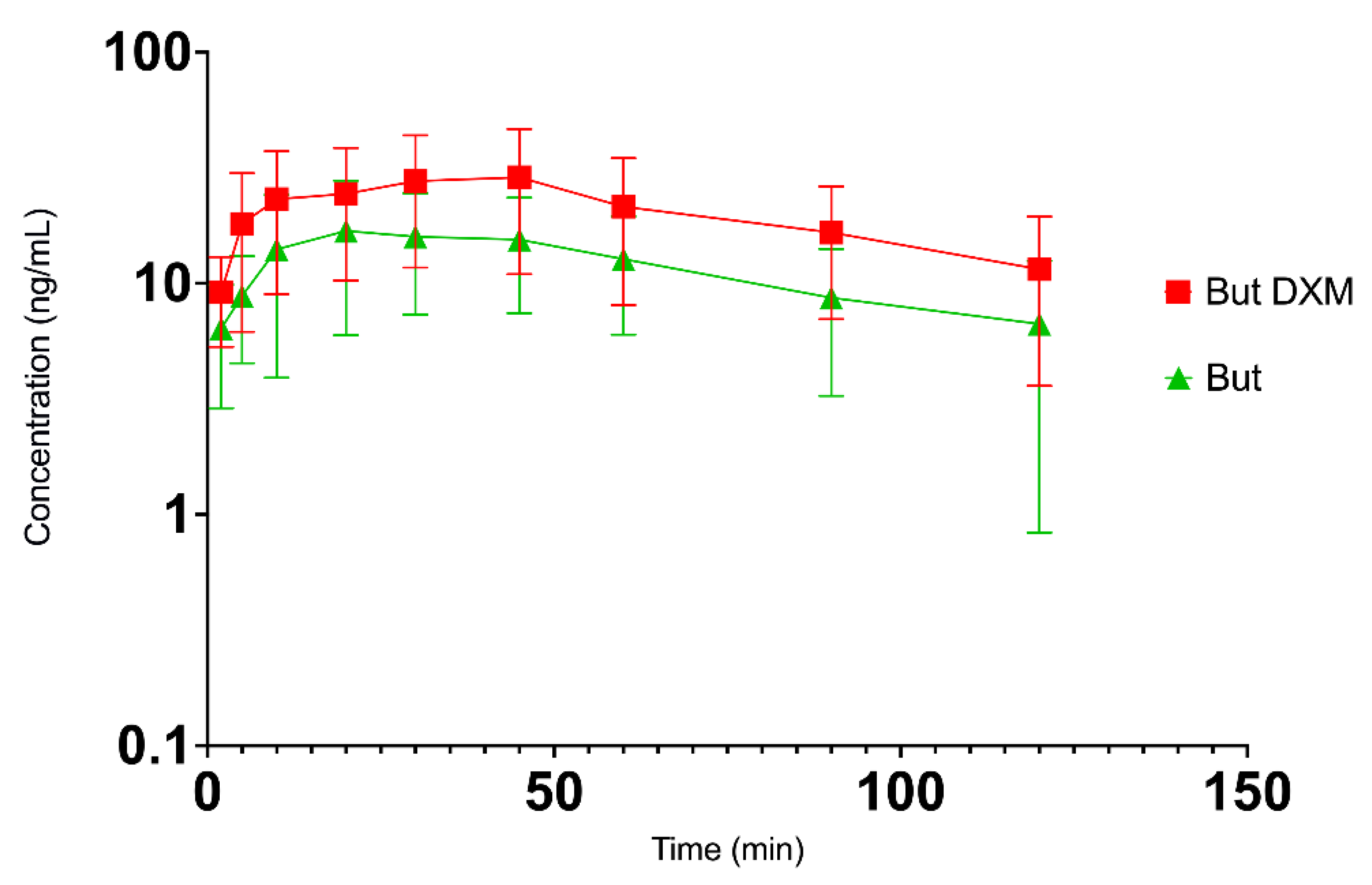
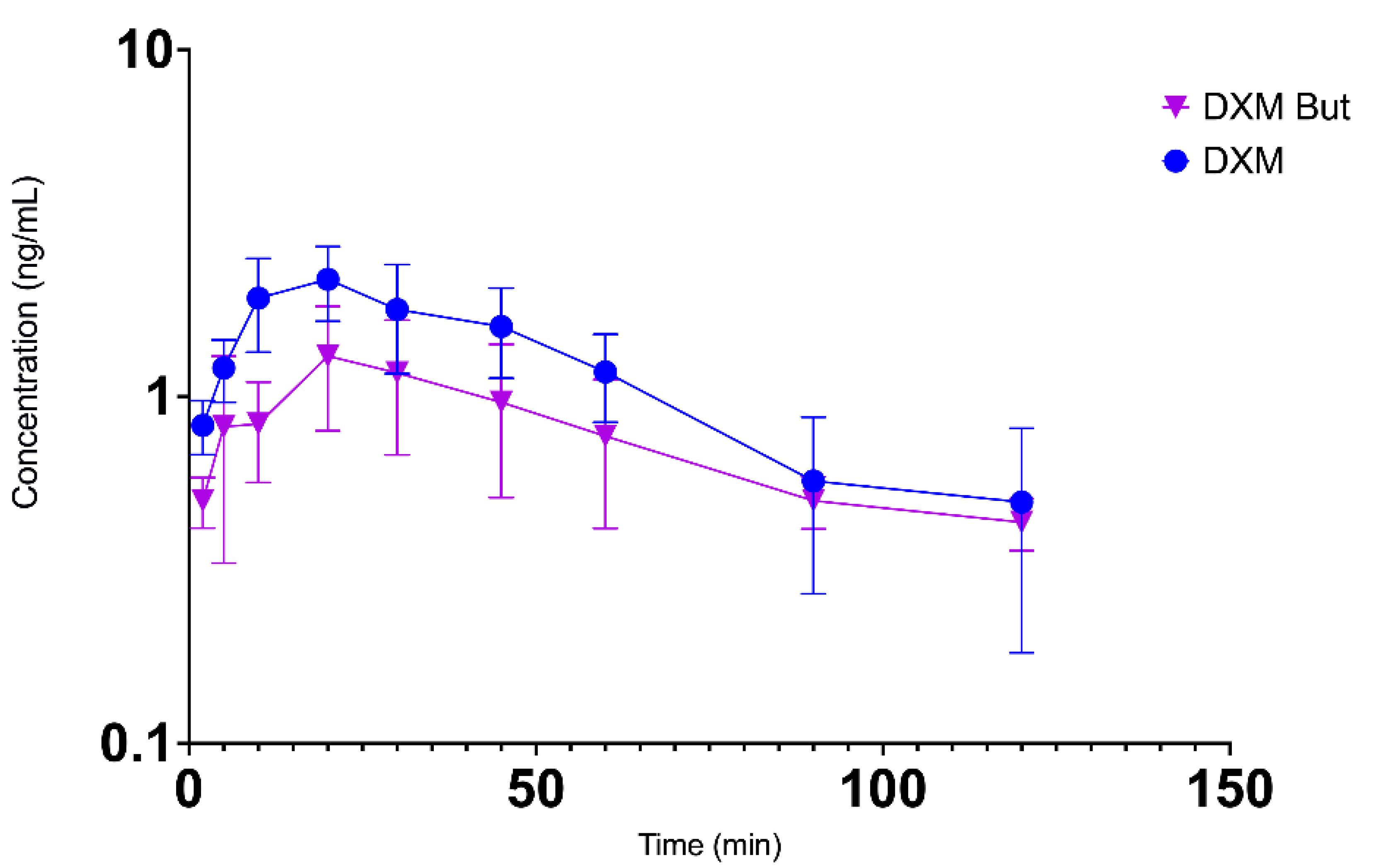
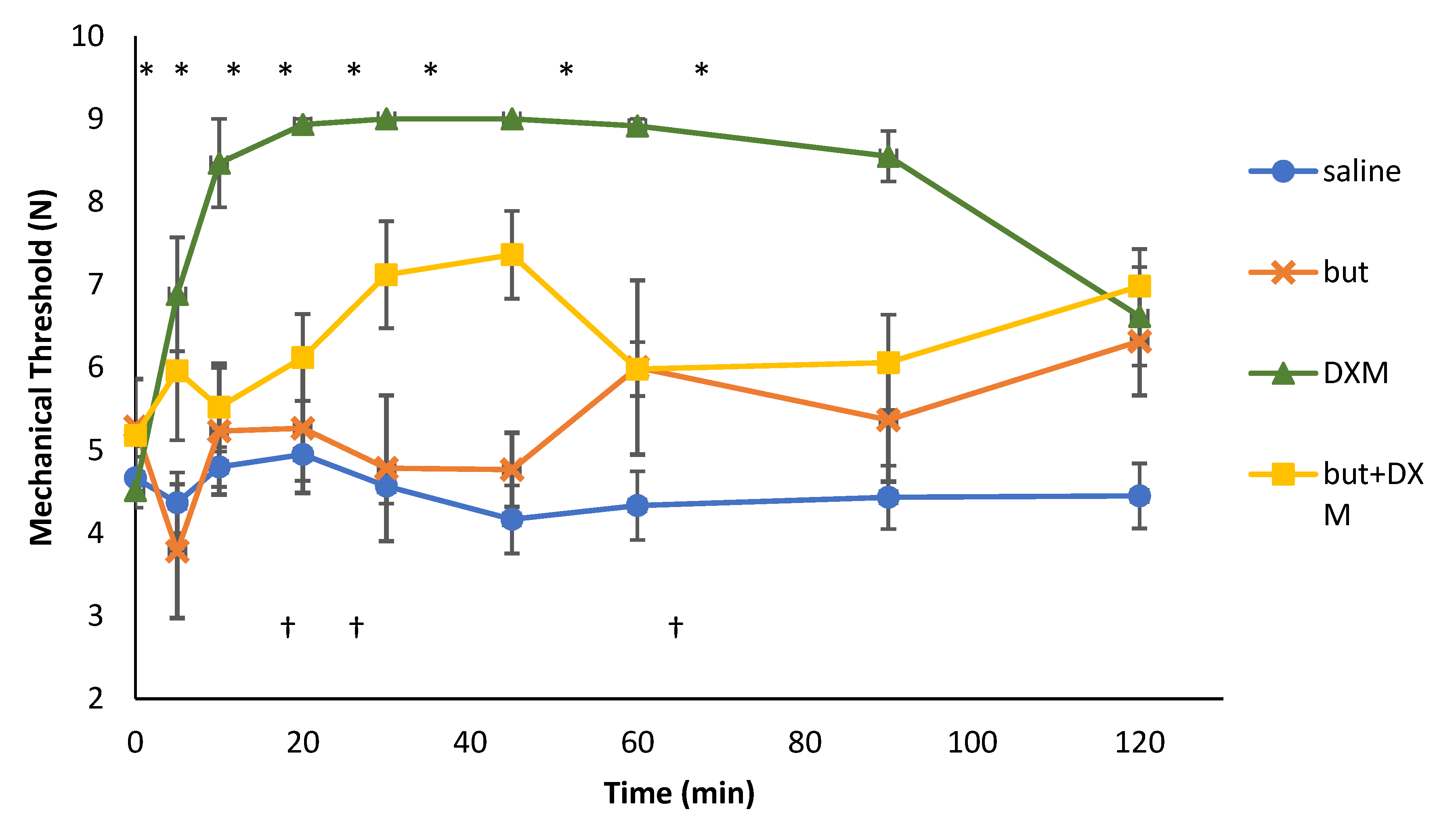
| Time (min) | Sedation Score § (Least Square Mean † ± Standard Error) in Different Groups | |||
|---|---|---|---|---|
| Saline | But | DXM | But + DXM | |
| 0 | 0 ± 0.22 | 0 ± 0.27 | 0 ± 0.22 | 0 ± 0.26 |
| 5 | 0.50 a ± 0.22 | 0.50 a ± 0.27 | 1.50 *b ± 0.22 | 0.33 a ± 0.26 |
| 10 | 0.17 a ± 0.22 | 0.50 ac ± 0.27 | 1.67 *b ± 0.22 | 0.83 c ± 0.26 |
| 20 | 0.17 a ± 0.22 | 0.67 ac ± 0.27 | 2.17 *b ± 0.22 | 0.83 c ± 0.26 |
| 30 | 0.50 a ± 0.22 | 0.50 a ± 0.27 | 2.17 *b ± 0.22 | 0.83 a ± 0.26 |
| 45 | 0.17 a ± 0.22 | 0.50 ac ± 0.27 | 2.17 *b ± 0.22 | 0.83 c ± 0.26 |
| 60 | 0.50 a ± 0.22 | 0.50 a ± 0.27 | 2.17 *b ± 0.22 | 1.00 a ± 0.26 |
| 90 | 0.33 a ± 0.22 | 0.83 a ± 0.27 | 1.33 *b ± 0.22 | 0.83 ab ± 0.26 |
| 120 | 0.33 a ± 0.22 | 0.67 a ± 0.27 | 0.83 a ± 0.22 | 0.83 a ± 0.26 |
| PK Parameter (Unit) | But | But with DXM | DXM | DXM with But |
|---|---|---|---|---|
| T1/2 elim (min) | 69.81 ± 20.26 | 77.07 ± 13.96 | 55.08 ± 11.62 | 152.23 ± 74.87 |
| Tmax (min) | 30.00 ± 5.00 | 29.17 ± 8.21 | 25.83 ± 4.17 | 20.83 ± 3.75 |
| Cmax (ng/mL) | 23.05 ± 6.21 | 34.54 ± 6.92 | 2.31 ± 0.19 * | 1.43 ± 0.20 |
| AUC0 to 120 (ng min/mL) | 1626.58 ± 389.94 | 2443.78 ± 481.71 | 144.53 ± 13.40 * | 92.94 ± 12.05 |
| AUC0 to inf (ng min/mL) | 2637.03 ± 864.16 | 3716.11 ± 776.85 | 193.46 ± 29.79 | 192.69 ± 49.68 |
| MRT (min) | 110.40 ± 29.11 | 116.48 ± 17.41 | 82.76 ± 16.65 | 218.48 ± 104.46 |
| Vss/F (L/kg) | 107.80 ± 31.91 | 68.66 ± 13.91 | 33.19 ± 5.84 * | 76.11 ± 16.29 |
| Cl/F (L/min/kg) | 2.55 ± 0.77 | 1.27 ± 0.2 | 0.95 ± 013 | 1.03 ± 0.7 |
| Time (Minute) | Mechanical Nociceptive Threshold (N; Mean ± SD) | |||
|---|---|---|---|---|
| Saline | But d | DXM ac | But + DXM b | |
| 0 (baseline) | 4.67 ± 0.26 | 5.28 ± 0.58 | 4.52 ± 0.21 | 5.18 ± 0.13 |
| 5 | 4.37 ± 0.37 | 3.78 ± 0.81 | 6.88 ± 0.69 * | 5.96 ± 0.84 |
| 10 | 4.8 ± 0.24 | 5.23 ± 0.77 | 8.47 ± 0.53 * | 5.52 ± 0.53 |
| 20 | 4.95 ± 0.32 | 5.27 ± 0.78 | 8.93 ± 0.07 * | 6.12 ± 0.52 |
| 30 | 4.57 ± 0.21 | 4.78 ± 0.88 | 9 ± 0 * | 7.12 ± 0.65 † |
| 45 | 4.17 ± 0.41 | 4.77 ± 0.45 | 9 ± 0 * | 7.36 ± 0.53 † |
| 60 | 4.33 ± 0.41 | 6 ± 1.05 | 8.92 ± 0.08 * | 5.98 ± 0.32 |
| 90 | 4.43 ± 0.38 | 5.37 ± 0.74 | 8.55 ± 0.31 * | 6.06 ± 0.58 |
| 120 | 4.45 ± 0.39 | 6.32 ± 0.65 | 6.62 ± 0.59 * | 6.98 ± 0.45 † |
Publisher’s Note: MDPI stays neutral with regard to jurisdictional claims in published maps and institutional affiliations. |
© 2022 by the authors. Licensee MDPI, Basel, Switzerland. This article is an open access article distributed under the terms and conditions of the Creative Commons Attribution (CC BY) license (https://creativecommons.org/licenses/by/4.0/).
Share and Cite
Sha, J.; Kongara, K.; Singh, P.; Jacob, A.; Ponnampalam, J. Pharmacokinetics and Pharmacodynamics of Butorphanol and Dexmedetomidine after Intranasal Administration in Broiler Chickens (Gallus gallus domesticus). Vet. Sci. 2022, 9, 212. https://doi.org/10.3390/vetsci9050212
Sha J, Kongara K, Singh P, Jacob A, Ponnampalam J. Pharmacokinetics and Pharmacodynamics of Butorphanol and Dexmedetomidine after Intranasal Administration in Broiler Chickens (Gallus gallus domesticus). Veterinary Sciences. 2022; 9(5):212. https://doi.org/10.3390/vetsci9050212
Chicago/Turabian StyleSha, Jin, Kavitha Kongara, Preet Singh, Antony Jacob, and Jeyamohan Ponnampalam. 2022. "Pharmacokinetics and Pharmacodynamics of Butorphanol and Dexmedetomidine after Intranasal Administration in Broiler Chickens (Gallus gallus domesticus)" Veterinary Sciences 9, no. 5: 212. https://doi.org/10.3390/vetsci9050212
APA StyleSha, J., Kongara, K., Singh, P., Jacob, A., & Ponnampalam, J. (2022). Pharmacokinetics and Pharmacodynamics of Butorphanol and Dexmedetomidine after Intranasal Administration in Broiler Chickens (Gallus gallus domesticus). Veterinary Sciences, 9(5), 212. https://doi.org/10.3390/vetsci9050212






